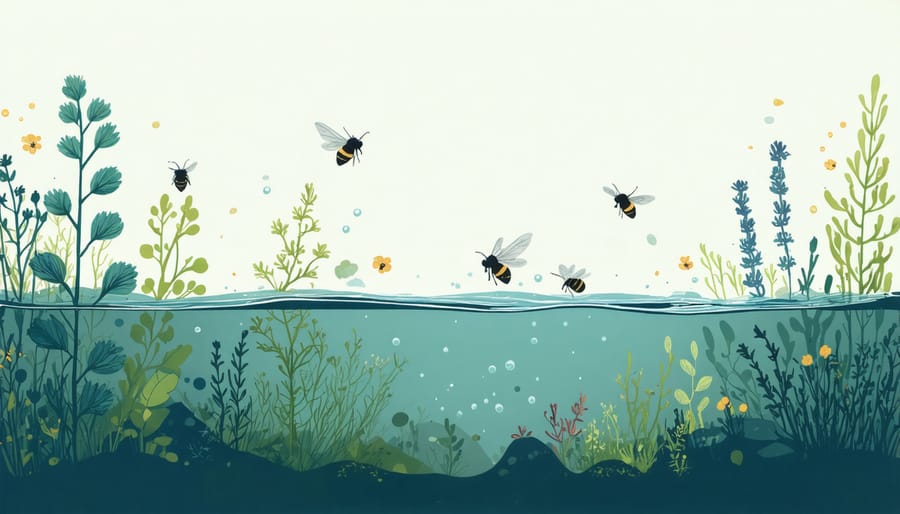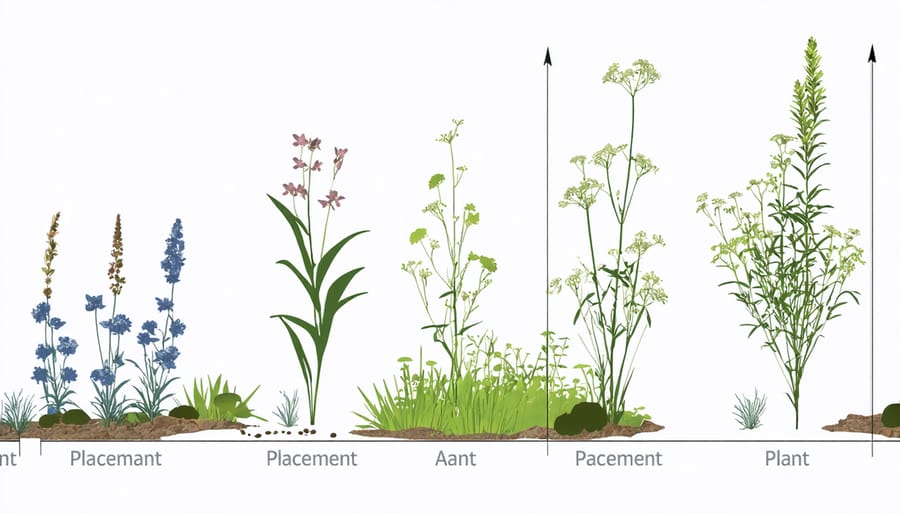
Transform Your Water Garden Into a Pollinator Paradise (Your Complete Action Plan)
Transform your water garden into a vibrant pollinator paradise by strategically selecting native aquatic plants that bloom throughout multiple seasons. Position shallow-water species like marsh marigolds and pickerelweed along the edges of your backyard pond design ideas, creating essential landing zones for bees and butterflies. Incorporate vertical elements through emergent plants such as cattails and iris, which provide both nectar sources and natural perches for pollinators to rest between feedings.
The relationship between aquatic plants and their pollinators represents one of nature’s most fascinating partnerships. While honeybees and butterflies grab the spotlight, lesser-known pollinators like hover flies and native bees play equally crucial roles in maintaining healthy water garden ecosystems. These beneficial insects not only ensure successful plant reproduction but also contribute to the overall biodiversity of your aquatic sanctuary.
By understanding these plant-pollinator dynamics, water gardeners can create thriving ecosystems that support local pollinator populations while enhancing the visual appeal of their water features. The key lies in providing diverse flowering options, maintaining clean water conditions, and establishing zones that accommodate different pollinator feeding and resting preferences.
Why Your Water Garden Needs Pollinators
The Hidden Benefits for Your Pond
While pollinators are well-known for their role in flowering gardens, they bring surprising benefits to your pond ecosystem. When these helpful creatures visit your water garden, they do more than just pollinate your floating and marginal plants – they create a vibrant, self-sustaining environment.
Pollinators help your aquatic plants reproduce more efficiently, leading to stronger, healthier growth and natural spread. This means you’ll spend less money replacing plants each season. They also attract beneficial insects that feed on common pond pests like mosquito larvae, helping maintain the natural balance of your water feature.
These welcome visitors contribute to your pond’s biodiversity by spreading pollen between different water gardens in your neighborhood, introducing genetic diversity that makes plants more resilient to diseases and environmental stress. As an added bonus, the movement of pollinators creates fascinating ripples across your pond’s surface, adding to its sensory appeal.
Many pond-visiting pollinators also serve as food sources for fish and amphibians, supporting a thriving ecosystem. The presence of these creatures indicates a healthy, well-balanced water garden that will continue to flourish season after season.
Common Water Garden Pollinators
Water gardens attract a diverse array of fascinating pollinators that bring life and movement to your aquatic oasis. Dragonflies and damselflies are among the most striking visitors, darting above the water’s surface while helping to control mosquito populations. These elegant insects are not only beautiful but serve as indicators of a healthy water garden ecosystem.
Bees, particularly honey bees and native bees, are frequent visitors to water gardens, especially when you include flowering marginal plants. They’re drawn to both the water source and nectar-rich blooms. Butterflies, including monarchs and swallowtails, often visit water gardens to drink from shallow puddles and feed on flowering plants near the water’s edge.
Moths, particularly hawk moths, become active during evening hours, pollinating night-blooming water lilies and other aquatic plants. Hummingbirds are also common visitors, especially attracted to red and tubular flowers commonly found in water garden settings.
Even some beetles and flies play important roles as pollinators in water gardens, though they’re often overlooked. These insects help maintain biodiversity and ensure successful plant reproduction throughout your water feature.

Best Pollinator-Friendly Plants for Water Gardens
Marginal Plants That Attract Pollinators
The transition between your pond and garden creates a perfect opportunity to support local pollinators. Marginal plants, which grow in shallow water or consistently moist soil around your pond’s edge, can turn this space into a buzzing hub of beneficial insect activity.
Cardinal flower, with its brilliant red blooms, is a magnet for hummingbirds and butterflies, while also tolerating wet feet near the water’s edge. Purple loosestrife, although requiring careful management to prevent spreading, produces gorgeous purple spikes that bees simply can’t resist.
For shorter options, try marsh marigolds, whose cheerful yellow flowers emerge in early spring when pollinators need them most. Swamp milkweed is another excellent choice, serving as both a nectar source for adult butterflies and a crucial host plant for monarch caterpillars.
Don’t overlook iris varieties like the native blue flag iris, which provides both beauty and functionality. Its sturdy stems offer landing pads for bees, while its flowers produce abundant nectar. Pickerelweed, with its purple-blue flower spikes, attracts numerous pollinators while helping stabilize pond edges.
For best results, plant these marginals in groups rather than individually. This creates visible “landing zones” for pollinators and makes your pond’s edge more visually striking. Remember to maintain varying bloom times throughout the season to provide consistent food sources for your beneficial visitors.

Floating Plants for Pollinator Success
Floating plants play a vital role in creating a pollinator paradise in your water garden. These aquatic beauties not only add visual interest but also provide essential landing pads and food sources for various pollinators, including bees, butterflies, and even hummingbirds.
Water lilies are the stars of floating plants, offering large, flat surfaces where insects can safely land while collecting nectar. Their vibrant blooms in pink, white, yellow, and purple attract pollinators from dawn to dusk. For smaller water features, consider miniature water lilies that provide the same benefits in a compact size.
Lotus plants are another excellent choice, with their massive flowers rising above the water’s surface on sturdy stems. These sacred plants produce long-lasting blooms that serve as perfect pollinator platforms, while their large leaves offer additional landing spots.
Don’t overlook the value of free-floating plants like water hyacinth and water lettuce. These plants create dense mats of foliage that support smaller pollinators and provide shelter for beneficial insects. Their delicate flowers are particularly attractive to native bees and hover flies.
For best results, aim to include a mix of different floating plants that bloom at various times throughout the season. This ensures a continuous food source for pollinators from spring through fall. Remember to maintain proper coverage – about 60% of your water surface should remain open to maintain healthy water conditions while still providing ample pollinator habitat.
Surrounding Garden Integration
Creating a seamless transition between your water garden and the surrounding landscape is essential for a cohesive and pollinator-friendly environment. Through smart plant integration, you can establish natural corridors that encourage pollinators to move freely between different garden zones.
Start by selecting plants that complement both aquatic and terrestrial environments. Plant taller specimens like ornamental grasses or flowering shrubs at the back of your water garden, gradually transitioning to shorter plants as you move toward the water’s edge. This creates a natural-looking gradient that’s appealing to both humans and pollinators.
Consider using native plants that naturally occur together in your local ecosystem. These plants will not only thrive in your climate but also provide familiar food sources for local pollinators. Try grouping plants in odd numbers and repeating certain species throughout your garden to create visual rhythm and continuous blooming cycles.
Don’t forget to include stepping stones or pathways that allow you to maintain both your water garden and surrounding beds easily. These paths can double as attractive design elements while providing practical access for garden maintenance.
By blending your water garden with the surrounding landscape, you’ll create an inviting space that supports local wildlife while enhancing your garden’s overall beauty and ecological value.
Creating Your Pollinator-Friendly Water Garden
Strategic Plant Placement
Strategic plant placement is key to creating a thriving ecosystem that attracts and sustains pollinators in your garden. Just like how small water garden filters keep your pond healthy, thoughtful plant arrangement ensures a flourishing pollinator habitat.
Start by creating “pollinator corridors” – continuous paths of flowering plants that guide pollinators through your garden. Place taller plants like Joe Pye Weed and Purple Loosestrife at the back of borders, with medium-height plants like Cardinal Flower and Marsh Marigold in the middle, and shorter options like Water Forget-me-not at the front.
Group similar plants together in clusters of at least three to five specimens. This clustering makes it easier for pollinators to spot their favorite flowers and helps them conserve energy while feeding. Remember to include plants with different blooming periods to provide food sources throughout the growing season.
Consider sun exposure when arranging your plants. Most pollinator-friendly flowers prefer full sun, so position them where they’ll receive at least six hours of direct sunlight daily. Create windbreaks using shrubs or taller plants to protect more delicate flowers and make it easier for pollinators to visit them.
Leave some open areas between plant groupings for pollinators to rest and navigate. These spaces also make maintenance easier and prevent overcrowding. If you have a larger garden, consider creating multiple pollinator-friendly zones connected by flowering pathways to encourage movement throughout the space.
Include both shallow and deep-water plants in your pond to attract different types of pollinators. Edge plants like Iris and Rush provide perfect landing spots for butterflies and bees, while floating plants offer additional feeding stations.

Seasonal Considerations
Creating a year-round haven for pollinators requires thoughtful planning across seasons. In spring, early-blooming plants like pussy willows and marsh marigolds provide crucial nectar for emerging pollinators. These early food sources are essential for bees and butterflies awakening from winter dormancy.
Summer brings peak pollinator activity, making it the perfect time to showcase a variety of water-loving plants with different blooming periods. Consider staggering bloom times by combining early-summer favorites like pickerelweed with mid-season water lilies and late-summer flowering rush. This succession ensures continuous food sources for pollinators throughout the warm months.
As autumn approaches, late-blooming plants become vital resources. Cardinal flower and swamp milkweed offer essential nutrition for pollinators preparing for migration or winter. Leave spent flower heads standing through fall, as they provide both food and shelter for beneficial insects.
Winter planning is equally important, though less obvious. Leave dried plant stalks and seed heads in place until spring cleanup. These provide winter homes for native bees and other beneficial insects. Consider adding evergreen plants near your water garden to create windbreaks and shelter for overwintering pollinators.
Remember to maintain some consistent water sources throughout the year. Even in winter, pollinators may become active during warm spells and need access to water. A small heated bird bath or protected shallow water area can serve this purpose when natural water features are frozen.
By thinking seasonally and providing year-round resources, your water garden can support healthy pollinator populations throughout the changing seasons.
Maintenance Tips for Success
Maintaining a thriving pollinator-friendly garden requires consistent care and attention. Start by establishing a regular watering schedule that keeps your plants healthy without overwatering. Early morning watering is ideal, allowing plants to dry before evening and preventing fungal issues. Remember that proper water feature maintenance is crucial for both plants and pollinators.
Keep your garden chemical-free by using organic fertilizers and natural pest control methods. This protects beneficial insects and ensures your garden remains a safe haven for pollinators. Deadhead spent blooms regularly to encourage continuous flowering and remove any diseased plant material promptly to prevent spread.
Create designated “messy areas” by leaving some fallen leaves and stems during autumn and winter. These provide essential shelter for overwintering pollinators and beneficial insects. Install small water sources, like shallow dishes with pebbles, where pollinators can safely drink without drowning.
Monitor your plants regularly for signs of stress or disease, and adjust care routines accordingly. Prune carefully and strategically, avoiding heavy pruning during peak flowering periods when pollinators are most active. Consider setting up a maintenance calendar to track seasonal tasks and flowering cycles.
Finally, maintain clear pathways between plants to allow pollinators easy access to flowers. This also makes it easier for you to perform regular garden maintenance without disturbing their important work.
Creating a pollinator-friendly water garden is a rewarding journey that benefits both your outdoor space and local ecosystem. As we’ve explored, these gardens serve as vital habitats for pollinators while adding beauty and tranquility to your landscape. By selecting the right aquatic and marginal plants, you’re not only creating a stunning water feature but also supporting essential pollinator populations that keep our environment thriving.
Remember that successful pollinator gardens don’t require massive spaces or expert knowledge. Even a small container water garden can make a difference. Start with a few native plants, ensure proper water depth and soil conditions, and watch as your garden becomes a bustling hub of activity. The combination of water and pollinator-friendly plants creates a unique microhabitat that attracts diverse wildlife, from bees and butterflies to dragonflies and birds.
Don’t be afraid to experiment with different plant combinations and arrangements. Your water garden will evolve as you learn what works best in your specific environment. The key is to maintain consistency in care while allowing nature to take its course. Consider joining local gardening groups or sharing your experiences with fellow water garden enthusiasts to learn and grow together.
Take that first step today toward creating your pollinator paradise. Your efforts will contribute to pollinator conservation while providing endless enjoyment and learning opportunities right in your backyard.
